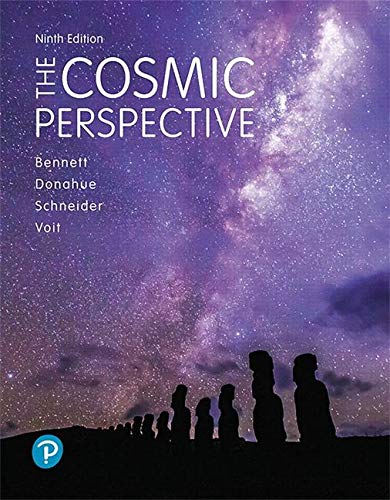
The Cosmic Perspective (9th Edition)
9th Edition
ISBN: 9780134874364
Author: Jeffrey O. Bennett, Megan O. Donahue, Nicholas Schneider, Mark Voit
Publisher: PEARSON
expand_more
expand_more
format_list_bulleted
Concept explainers
Textbook Question
Chapter 4, Problem 7EAP
Define temperature and thermal energy. How are they related? How are they different?
Expert Solution & Answer
Want to see the full answer?
Check out a sample textbook solution
Students have asked these similar questions
3
Set
ба
||Axl
49.32
6b
71
Ay
22
Magnitude of A
Angle of A
24.04
Angle of -A
22
54
155.96
° (pos Ax) 204.04
° (neg Ax) 335.96
°
(pos Ax)
° (neg Ax)
115.77
° (pos Ax) 295.77
° (pos Ax)
-39
81
208.78
° (neg Ax) 28.78
°
(neg Ax)
3AA . not sure what i am getting wrong
Chapter 4 Solutions
The Cosmic Perspective (9th Edition)
Ch. 4 - Prob. 1VSCCh. 4 - Use the following questions to check your...Ch. 4 - Use the following questions to check your...Ch. 4 - Use the following questions to check your...Ch. 4 - Use the following questions to check your...Ch. 4 - Define speed, velocity, and acceleration. What are...Ch. 4 - Define momentum and force. What do we mean when we...Ch. 4 - What is free-fall, and why does it make you...Ch. 4 - Prob. 4EAPCh. 4 - Describe the laws of conservation of momentum, of...
Ch. 4 - Define kinetic energy, radiative energy, and...Ch. 4 - Define temperature and thermal energy. How are...Ch. 4 - Prob. 8EAPCh. 4 - 9. Summarize the universal law of gravitation both...Ch. 4 - 10. What is the difference between a bound and an...Ch. 4 - What do we need to know if we want to measure an...Ch. 4 - Explain why orbits cannot change spontaneously,...Ch. 4 - Explain how the Moon creates tides on Earth. Why...Ch. 4 - What is tidal friction? What effects does it have...Ch. 4 - Does It Make Sense?
Decide whether the statement...Ch. 4 - Does It Make Sense?
Decide whether the statement...Ch. 4 - Does It Make Sense?
Decide whether the statement...Ch. 4 - Does It Make Sense?
Decide whether the statement...Ch. 4 - Prob. 19EAPCh. 4 - Prob. 20EAPCh. 4 - Does It Make Sense? Decide whether the statement...Ch. 4 - Does It Make Sense?
Decide whether the statement...Ch. 4 - Does It Make Sense?
Decide whether the statement...Ch. 4 - Does It Make Sense?
Decide whether the statement...Ch. 4 - Choose the best answer to each of the following....Ch. 4 - Choose the best answer to each of the following....Ch. 4 - Choose the best answer to each of the following....Ch. 4 - Choose the best answer to each of the following....Ch. 4 - Choose the best answer to each of the following....Ch. 4 - Prob. 30EAPCh. 4 - Prob. 31EAPCh. 4 - Choose the best answer to each of the following....Ch. 4 - Choose the best answer to each of the following....Ch. 4 - Choose the best answer to each of the following....Ch. 4 - Prob. 35EAPCh. 4 - Testing Gravity. Scientists are continually trying...Ch. 4 - Prob. 38EAPCh. 4 - Prob. 39EAPCh. 4 - Prob. 40EAPCh. 4 - Weightlessness. Astronauts are weightless when in...Ch. 4 - Units of Acceleration. If you drop a rock from a...Ch. 4 - Gravitational Potential Energy. For each of the...Ch. 4 - Prob. 44EAPCh. 4 - The Gravitational Law. How does quadrupling the...Ch. 4 - Allowable Orbits? Suppose the Sun were replaced by...Ch. 4 - Head-to-Foot Tides. You and Earth attract each...Ch. 4 - Prob. 48EAPCh. 4 - Geostationary Orbit. A satellite in geostationary...Ch. 4 - Prob. 51EAPCh. 4 - Prob. 52EAPCh. 4 - Moving Candy Bar. Table 4.1 shows that...Ch. 4 - Spontaneous Human Combustion. Suppose that all the...Ch. 4 - Fusion Power. No one has yet succeeded in creating...Ch. 4 - Understanding Newton’s Version of Kepler’s Third...Ch. 4 - Using Newton’s Version of Kepler’s Third Law....Ch. 4 - Escape Velocity. Calculate the escape velocity...Ch. 4 - Weights on Other Worlds. Calculate the...Ch. 4 - Prob. 60EAPCh. 4 - Extra Moon. Suppose Earth had a second moon,...
Knowledge Booster
Learn more about
Need a deep-dive on the concept behind this application? Look no further. Learn more about this topic, physics and related others by exploring similar questions and additional content below.Similar questions
arrow_back_ios
SEE MORE QUESTIONS
arrow_forward_ios
Recommended textbooks for you
 Stars and Galaxies (MindTap Course List)PhysicsISBN:9781337399944Author:Michael A. SeedsPublisher:Cengage Learning
Stars and Galaxies (MindTap Course List)PhysicsISBN:9781337399944Author:Michael A. SeedsPublisher:Cengage Learning AstronomyPhysicsISBN:9781938168284Author:Andrew Fraknoi; David Morrison; Sidney C. WolffPublisher:OpenStax
AstronomyPhysicsISBN:9781938168284Author:Andrew Fraknoi; David Morrison; Sidney C. WolffPublisher:OpenStax Foundations of Astronomy (MindTap Course List)PhysicsISBN:9781337399920Author:Michael A. Seeds, Dana BackmanPublisher:Cengage Learning
Foundations of Astronomy (MindTap Course List)PhysicsISBN:9781337399920Author:Michael A. Seeds, Dana BackmanPublisher:Cengage Learning Horizons: Exploring the Universe (MindTap Course ...PhysicsISBN:9781305960961Author:Michael A. Seeds, Dana BackmanPublisher:Cengage Learning
Horizons: Exploring the Universe (MindTap Course ...PhysicsISBN:9781305960961Author:Michael A. Seeds, Dana BackmanPublisher:Cengage Learning
 Stars and GalaxiesPhysicsISBN:9781305120785Author:Michael A. Seeds, Dana BackmanPublisher:Cengage Learning
Stars and GalaxiesPhysicsISBN:9781305120785Author:Michael A. Seeds, Dana BackmanPublisher:Cengage Learning

Stars and Galaxies (MindTap Course List)
Physics
ISBN:9781337399944
Author:Michael A. Seeds
Publisher:Cengage Learning

Astronomy
Physics
ISBN:9781938168284
Author:Andrew Fraknoi; David Morrison; Sidney C. Wolff
Publisher:OpenStax

Foundations of Astronomy (MindTap Course List)
Physics
ISBN:9781337399920
Author:Michael A. Seeds, Dana Backman
Publisher:Cengage Learning

Horizons: Exploring the Universe (MindTap Course ...
Physics
ISBN:9781305960961
Author:Michael A. Seeds, Dana Backman
Publisher:Cengage Learning


Stars and Galaxies
Physics
ISBN:9781305120785
Author:Michael A. Seeds, Dana Backman
Publisher:Cengage Learning
A Level Physics – Ideal Gas Equation; Author: Atomi;https://www.youtube.com/watch?v=k0EFrmah7h0;License: Standard YouTube License, CC-BY